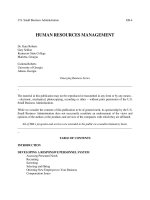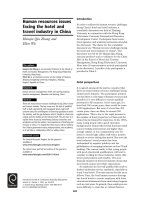human resources management _ section 6-compensation and employee benefits
Bạn đang xem bản rút gọn của tài liệu. Xem và tải ngay bản đầy đủ của tài liệu tại đây (2.66 MB, 51 trang )
Human Resource
Management
ESSENTIAL PERSPECTIVE
© 2005 Southwestern College Publishing. All rights reserved.
PowerPoint Presentation
by Truong Thi Lan Anh
Compensation and
Employee benefits (C&B)
Section 6
Robert L. Mathis John H. Jackson
© 2005 Southwestern College Publishing. All rights reserved. Lan Anh 12–2
Learning Objectives
After you have studied this section, you should be
able to:
– Understand the nature of compensation.
– Describe three considerations affecting perceptions of pay
fairness.
– Define
job evaluation
and its role in C&B
– Outline the process of building a wage and salary
administration system.
– Define variable pay.
– Identify different uses of individual vs. team plans in
terms of rewards and incentives.
– Define a benefit and identify two strategic reasons why
employers provide benefits.
© 2005 Southwestern College Publishing. All rights reserved. Lan Anh 12–3
Nature of Compensation
Compensation is the total amount of the
monetary and non-monetary pay rewarded to an
employee by an employer in return for work
performed as required.
Types of Rewards
– Intrinsic
• Intangible, psychological and social effects of compensation
• Ex. Challenging tasks, autonomy, & non-monetary benefits
– Extrinsic
• Tangible (direct or indirect), monetary and non-monetary
effects of compensation
• Ex. Praise, monetary incentives, recognition
© 2005 Southwestern College Publishing. All rights reserved.
A System of Rewards
© 2005 Southwestern College Publishing. All rights reserved. Lan Anh 12–5
Nature of Compensation
Compensation is based on…
– market research about the worth of similar jobs in the
marketplace,
– employee contributions and accomplishments,
– the availability of employees with like skills in the
marketplace,
– the desire of the employer to attract and retain a
particular employee for the value they are perceived to
add to the employment relationship, and
– the profitability of the company or the funds available
in a non-profit or public sector setting, and thus, the
ability of an employer to pay market-rate compensation
© 2005 Southwestern College Publishing. All rights reserved. Lan Anh 12–6
Compensation Systems
Objectives of an Effective
Compensation System:
– Legal compliance with all
appropriate laws and
regulations
– Cost effectiveness for the
organization
– Internal, external, and
individual equity for
employees
– Performance enhancement for
the organization
© 2005 Southwestern College Publishing. All rights reserved. Lan Anh 12–7
Components of A Compensation Program
Figure 12–1
© 2005 Southwestern College Publishing. All rights reserved. Lan Anh 12–8
Direct Compensation
Compensation Type
Base Pay
The basic monetary compensation that an
employee receives, usually as a wage or
salary.
Wages
Payments calculated on the amount of time
worked.
Salary
Consistent payments made each period
regardless of the number of hours worked in
the period.
Variable Pay
Compensation linked to individual, team, or
organizational performance.
Benefit
An indirect reward given to an employee or
group of employees as a part of
organizational membership.
© 2005 Southwestern College Publishing. All rights reserved. Lan Anh 12–9
Typical Division of HR Responsibilities:
Compensation
Figure 12–2
© 2005 Southwestern College Publishing. All rights reserved. Lan Anh 12–10
Continuum of Compensation Philosophies
Figure 12–3
© 2005 Southwestern College Publishing. All rights reserved. Lan Anh 12–11
Compensation Approaches
Figure 12–4
© 2005 Southwestern College Publishing. All rights reserved. Lan Anh 12–12
Decisions About Compensation Levels
Compensation Strategies
Above-Market
Paying for higher qualified, more productive
workers.
Middle-Market
Attempting to balance of employer costs and
need to attract and retain employees.
Below-Market
Paying all that the firm can afford
Taking advantage of the abundant supply of
potential employees in a loose labor market.
© 2005 Southwestern College Publishing. All rights reserved. Lan Anh 12–13
Competency-Based Pay
Maintenance of
Competencies
Limitations
(How many?)
Pricing
Competencies
Training
Competency-
Based Pay
Systems
(KBP/SBP)
© 2005 Southwestern College Publishing. All rights reserved. Lan Anh 12–14
Individual vs. Team Rewards
Distribute variable rewards at the team level
Make system simple and understandable.
Using Team-Based Reward Systems
Use skill-based pay for the base.
Use variable pay based on business entity performance
Maintain a high degree of employee involvement
© 2005 Southwestern College Publishing. All rights reserved. Lan Anh 12–15
Perceptions of Pay Fairness
Equity
The perceived fairness between what a person
does (inputs) and what the person receives
(outcomes).
Procedural Justice
The perceived fairness of the process and
procedures use to make decisions about
employees
Distributive Justice
The perceived fairness in the distribution of
outcomes.
Pay Openness
The degree of openness or secrecy that an
organization allows regarding its pay system.
External Equity
The perception that the organization provides
employees with compensation that comparable
to the compensation of employees with similar
jobs in other organizations.
© 2005 Southwestern College Publishing. All rights reserved. Lan Anh 12–16
Equity Considerations in Compensation
Figure 12–7
© 2005 Southwestern College Publishing. All rights reserved. Lan Anh 12–17
Compensation
Administration
Process
Figure 12–10
© 2005 Southwestern College Publishing. All rights reserved. Lan Anh 12–18
Job Evaluation
The systematic determination of the relative
worth of jobs within an organization.
Priced according to:
Relative importance of the job
Knowledge, skills, & abilities (KSAs) needed to perform
the job
Difficulty of the job
© 2005 Southwestern College Publishing. All rights reserved. Lan Anh 12–19
Methods of Job Evaluation
Factor
Comparison
Ranking
Classification
Point
Method
Job
Evaluation
Methods
Integrated &
Computerized
Job Evaluations
© 2005 Southwestern College Publishing. All rights reserved. Lan Anh 12–20
Job Evaluation Point Chart
Figure 12–11
© 2005 Southwestern College Publishing. All rights reserved. Lan Anh 12–21
Pay Structures
Market Line
– The line on a graph showing the relationship
between the job value, as determined by job
evaluation points, and pay survey rates.
Common Pay Structures
– Hourly and salaried
– Office, plant, technical, professional, managerial
– Clerical, information technology, professional,
supervisory, management, and executive
© 2005 Southwestern College Publishing. All rights reserved. Lan Anh 12–22
Establishing
Pay
Structures
Figure 12–12
© 2005 Southwestern College Publishing. All rights reserved. Lan Anh 12–23
Pay Structures (cont’d)
Pay Grades
– A grouping of individual jobs having approximately
the same job worth.
Broadbanding
– The practice of using fewer pay grades having
broader pay ranges that in traditional systems.
– Benefits
• Encourages horizontal movement of employees
• Is consistent with trend towards flatter organizations
• Creates a more flexible organization
• Encourages competency development
• Emphasizes career development
© 2005 Southwestern College Publishing. All rights reserved. Lan Anh 12–24
Example of
Pay Grades
and Pay
Ranges
Figure 12–16
© 2005 Southwestern College Publishing. All rights reserved. Lan Anh 12–25
Pay Rate Issues
Rates Out of Range
– Red-Circled Employees
• An incumbent (current jobholder) who is paid above
the range set for the job.
– Green-Circled Employees
• An incumbent who is paid below the range set for the
job.
Pay Compression
– A situation in which pay differences among
individuals with different levels of experience and
performance in the organization becomes small.









